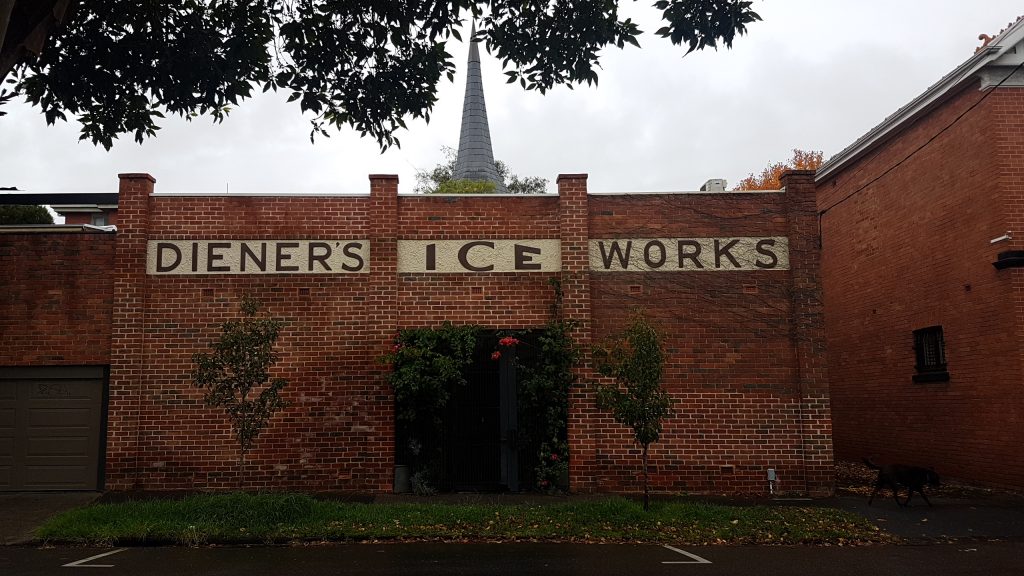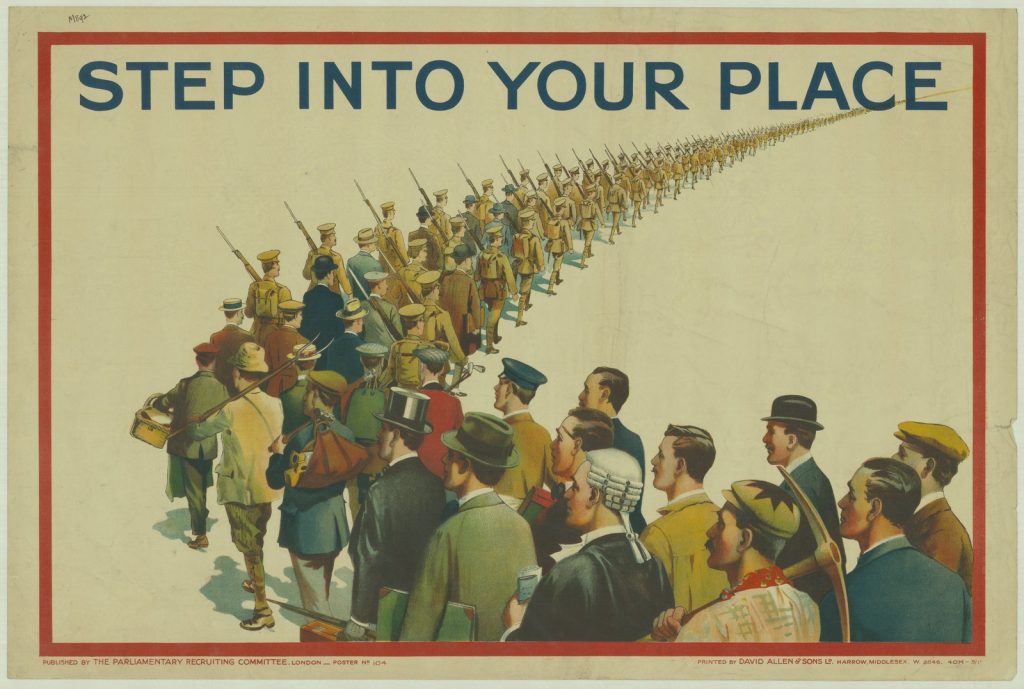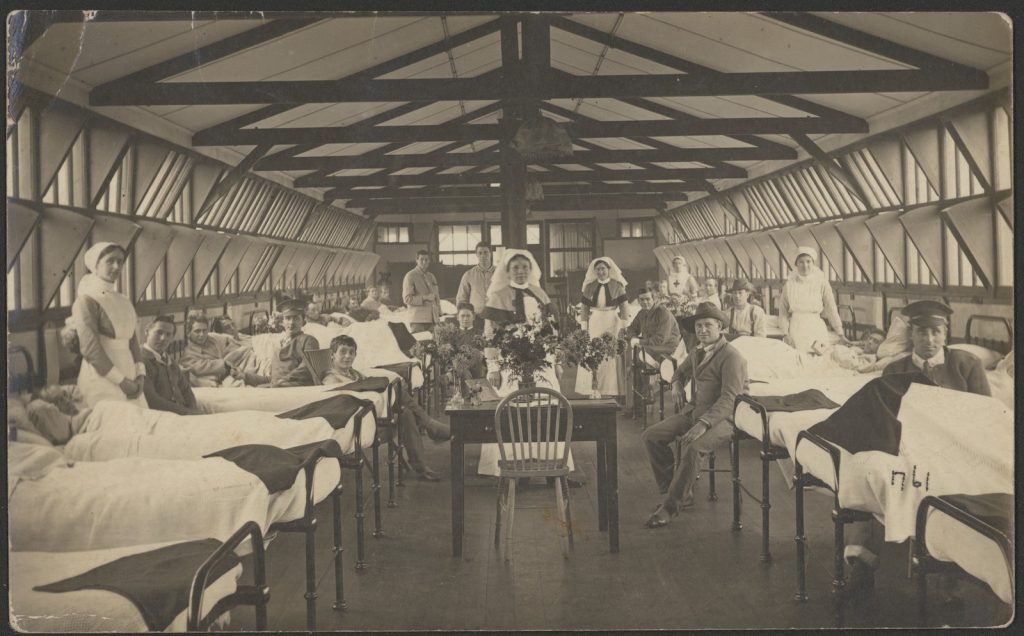This is the first of a two-part blog about flâneurs and research in the time of covid-19
A daily walk has become an essential part of many people’s routines in a way not seen in Australia since the fashionable promenading of the 19th century: we are all flâneurs now, if only for temporary reprieve from the indoors life we have had to adopt in response to the covid-19 pandemic. On one such constitutional recently I saw a ‘ghost sign’ on a local apartment building – an industrial conversion – that intrigued me: Diener’s Ice Works, on Perth St, Prahran. Who was Diener, who did his ice works serve, and what happened to the business? I trotted home to ask Google, expecting that someone else would have already explored the heritage of this eye-catching art deco building. To my surprise, there were no articles, blogs or books about Diener’s Ice Works – only a few Flickr photos, from fellow flâneurs passing by over the years.

It began to rain heavily outside, but I barely noticed the weather as from the comfort of an armchair, I tumbled deep down a research rabbit hole, following a trail that took me from late-19th-century rural Victoria to the horrors of the First World War in France, to the modernisation of suburban life in the 1930s, and to the post-war affluence and technological advances that reshaped life in the chrome-plated 1950s. Along the way, I pieced together the outline of a life, glimpsed through archival sources that are today available to us with unprecedented ease, at the click of a button. The story that follows is about the life of one man, about the times through which he lived, and about the possibilities of research through Australian digitized collections.
If you are a relative of Herbert Diener and would like to discuss or amend what follows, please do get in touch; I am acutely aware that I am writing here about a man’s life, not a trail of archival documents.
In writing the following I used only freely accessible information, but I have noted further information that is accessible after payment. The key resources I used were:
- AIF service records, digitized and available through the National Archives of Australia
- AIF unit war diaries 1914-1918, digitized and available through the Australian War Memorial
- Digitized newspapers, accessed through Trove, hosted by the National Library of Australia
- The Sands & McDougall Directory, digitized and available through State Library Victoria
You will find excellent guidance about undertaking research using these resources and others in the research guides created by my colleagues, especially in the guides found by selecting the ‘Family History’ facet.
Herbert Diener was born on 11 January 1899 in Branxholme, a small town southwestern in Victoria.[1] His parents, William Diener and Catherine/Katharine Amelia Gauld (or at least his father) came from Smithton in Tasmania. In his AIF enlistment papers, Diener would give his address as the nearby town of Condah and his occupation as ‘labourer’, a common enough type of employment for young men in rural Victoria.
The digitized newspapers accessible through the National Library of Australia’s Trove database give us our first major insight into Diener’s life. In April 1916, when he was 17 years old, Australians were weighing up the first anniversary of the disastrous 25 April 1915 landings at Gallipoli, in the midst of ongoing heavy losses of ANZAC soldiers in ‘the Great War’ on the other side of the world. It was a time of ferment and controversy. Debates about conscription raged as the Australian government came under increasing pressure from Britain to supply more troops. This pressure would culminate in two plebiscites (28 October and 12 December), both of which were won by the anti-conscription coalition. But back in April, Herbert Diener encountered one of the recruitment strategies of the desperate government: the Parliamentary Recruiting Committee to Casterton, western Victoria, Glenelg Shire (near border with South Australia). This Committee travelled by train, accompanied by the Royal Military Band and two wounded soldiers, intent on inspiring patriotic young men to enlist. They erected a platform in a Casterton street, and both the dignitaries and the wounded soldiers delivered stirring speeches (including a recitation of Henry Lawson’s poem ‘Star of Australasia’) interspersed with the band playing rousing military music. As described in an article in the Casterton Free Press and Glenelg Shire Advertiser on 27 April 1916, the wounded Sergeant Clements addressed the crowd: “Will you wait til Germany gets here before you have conscription?… What happened at Gallipoli was the finest thing that ever happened but it was also the biggest dis[appointment] that ever fell upon you, because [illegible] did not reinforce the men [illegible] there.” Diener signed up the next day, on 28 April 1916.

We pick up the story through Diener’s Australian Imperial Forces service record, digitized and accessible through the National Archives of Australia. His service number, 6249, unlocks his years serving in the 6th Battalion, an infantry battalion that participated in some of the most harrowing conflicts of the First World War, including the Gallipoli landings. These records provide staccato pieces of information about servicemen, but there is nuance and poignancy to be found in the relation of the details. I have not found a photograph of Diener, but his record tells us that in 1916, he was unmarried, 5 ft 8 inches tall, weighing 10.5 stone, with a fair complexion, brown eyes and fair hair. He was a Roman Catholic. There is more to some of the ‘facts’ presented: his age is given as 21, but he was in fact only 17; evidently he lied in order to enlist.
For the next four months, Diener spent quite a lot of time in military hospitals; it’s not clear if he was receiving treatment for pre-existing health concerns or whether he was injured during training. On 11 September 1916, he and his comrades set sail for Britain, disembarking at Plymouth on 26 October. On 31 December, the last day of the year, soldiers from the 6th Battalion sailed for France on the Princess Victoria. On 1 January, they marched for the base camp at Étaples, a notorious pit-stop for soldiers on their way to the Western Front. On 16 February 1917, Diener’s record notes he was “Taken on strength from reinforcements”, the standard phraseology when a soldier was sent to the front. The 6th Battalion was involved the Second Battle of Bullecourt, 3-7 May 1917, in which British and Imperial forces sought to take the village of Bullecourt from German troops, piercing the ‘Hindenburg Line’. The AIF unit war diaries provide a day-by-day account of the 6th Battalion’s activities. On Thursday 3 May, a ‘fine and warm’ day, we find them launching an attack on the Hindenburg Line at 3:45 a.m.: “casualties heavy”. On 7 May 1917, Diener was badly injured by a gunshot wound to the right thigh, one of only two men injured that day in his battalion. On 13 May, he was evacuated from Boulogne to England, his condition described as “serious”. On 15 June 1917, back at home in Australia, “Herbert Diener of Smithton” was reported as severely wounded, listed under ‘Tasmanians’ in The Mercury, the Hobart newspaper.

Diener would remain in hospitals until October, at which point his AIF record notes: “Wound healed. Knee movements free. Drop foot. Anaesthesia of foot.” This suggests he had a permanent disability from the injury, which makes it even stranger than although he arrived safely back in Australia on 21 December 1917, was discharged on 25 May 1918 and awarded an “incapacity pension” of 45 shillings per fortnight, he re-enlisted in the AIF on 9 September 1918 in Mackay, Queensland. This second enlistment seems to have been unhappy: he was disciplined several times for being absent without leave. In a memorable incident on 16 October 1918, he was given 72-hours confined to barracks for “conduct prejudicial to good order and military discipline”: “When order given ‘Eyes left’ made a burlesque of the order”. On 11 November 1918, the Armistice was signed and the war ended; on 31 December that year, Diener was again discharged from the AIF. We can only guess at the mental and physical trauma that he carried with him for the rest of his life as a result of his wartime experiences.
Read part two of this blog to find out what happened next, and how Herbert Diener came to open his Ice Works.
[1] Diener’s birth and death certificates could be purchased via Births, Deaths & Marriages Victoria: https://my.rio.bdm.vic.gov.au/efamily-history/5eb9e426d728981b2d2afb80/results?q=efamily.


I shared this post on my FB page and a friend left this comment:
“What a surprise seeing this Julie, it brings back a lot of memories.
Diener lce works was owned by my grandfather also a wood yard nearby, the ice works was run by my auntie Peggy & uncle lan Berry till closure some 30 years ago l think, ”
Thought it may be of interest to you,
Thank you Julie, that’s really exciting! Part Two of the blog will discuss the Ice Works – I wonder would your friend be happy to speak with me about it before the blog is posted? I will email you privately so that you have my address, and can pass it on.
My name is John Berry, Herbert Diener was my Grandfather,
My Mum was Peggy Berry (Diener) daughter of Herbert, I was born in 1954 and lived at 43 Greville Street Prahran this is the house that is on the corner and the Ice Works was built by my Grandfather at the back of the house, I lived there until 1967 with my parents Peggy and Ian and my older sister Jenny, in the early days when the Ice Works was still operating I used to help dad make the ice and ride in the trucks all over delivering the ice to customers.
Have lots of great memories of living at Dieners Ice Works, thanks for your interest in my family.
Dear John, thank you so much for getting in touch! I’ve removed your phone number from your comment, for privacy, but I would love to speak to you – I’ll send you an email to arrange a time for me to call. I look forward to learning more about your grandfather and your family’s history at the Ice Works. Best wishes, Anna
My name is John Berry, Herbert Diener was my Grandfather, I was born in 1954 and lived with my family at the Ice Works until 1967
I am very familiar with Prahran and its ghost signs, yet I have not seen this one in Greville Street, a street I know so well. I look forward to Part 2.
Hi Andrew, I hadn’t seen it until recently, either – I love spotting ghost signs too. The sign itself is on Perth St, but the address of the business was Greville St (it’s a corner property). I look forward to sharing Part 2!
I am his great-grandchild! Can put you in touch with his grand-children.
Hi Nicole, thanks so much! I will send you an email. John Berry, one of Herbert Diener’s grandchildren, has also been in touch (see below). It’s really wonderful to make contact with your family, and I look forward to learning more about Herbert’s story from you.
Hi Anna, Bert Diener was my great uncle. I posted a photo of him in uniform on your post on the SLV Facebook page. Regards, Elizabeth Turley
Hi Elizabeth, thanks so much for getting in touch and for sharing a photo of your great uncle! I’m nearly ready to share part two of this blog, which includes some photos of Bert shared with me by John Berry and Allen Feore. It’s been wonderful to connect with your family and learn more about Bert’s life. Part two should be published this week! Best wishes, Anna
I walked past there just the other week and also wondered about its history. Thankfully you have solved that 🙂
Andrew
Hi Andrew! And thank you 🙂 Very glad you enjoyed the blog.
Hi Anna, so glad you’re taking the time to look up and see the tops of buildings (where much of their history lies). You may be interested in the history of this site prepared by the Stonnington History Centre. See reference number SHC62013 on the History Centre’s catalogue at https://stonnington.spydus.com/cgi-bin/spydus.exe/ENQ/WPAC/ARCENQ?RNI=951669
Hi Simone, thanks very much for sharing this key research, which I did not find on my online travels! There’s some information in part two of this blog from Herbert’s family which amends and clarifies some of the details around Ice Work’s history as a business, especially at the end of its life, and the Diener family tree: Peggy Berry was Herbert and Keitha’s daughter, and her family took on the management of the business.
Great to see a story of the Ice Works and the family behind it. My grandfather Keith was a first cousin of Herbert Diener. I have collected quite a bit of material on the extended Diener family over the years. I am happy to share it with my relatives if they are interested.
Thank you Paul, lovely to read your comment. I’ll email you about your kind offer, to see if I can assist in connecting you all.
Best wishes,
Anna
Hi all, I am an immigrant from the UK, my family are Swiss originally (my great grandfather), I am a Diener , I wonder if there is any link? I have a pretty comprehensive family tree we could consult?!